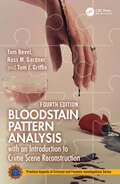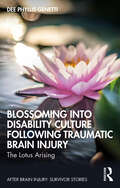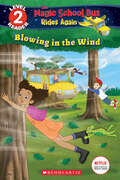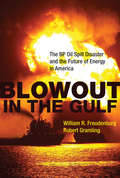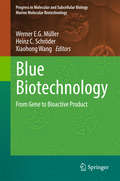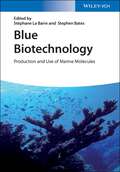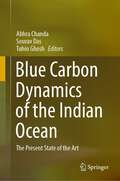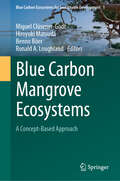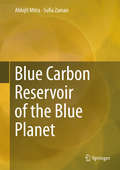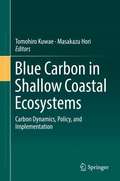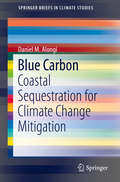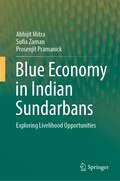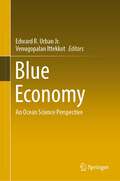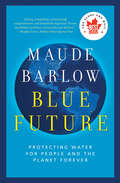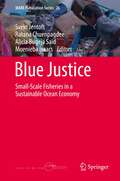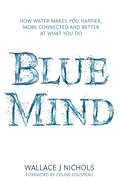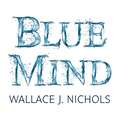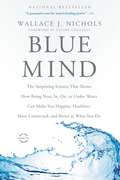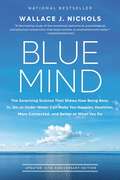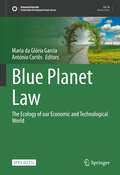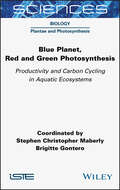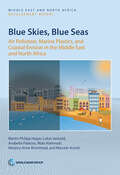- Table View
- List View
Bloodstain Pattern Analysis with an Introduction to Crime Scene Reconstruction (Practical Aspects of Criminal and Forensic Investigations)
by Ross M. Gardner Tom Bevel Tom J. GriffinBlood Stain Pattern Analysis with an Introduction to Crime Scene Reconstruction, Fourth Edition provides criminal investigators and forensic scientists with a complete and comprehensive handbook on bloodstain pattern analysis.Bringing over 90 combined years of practical experience—and thousands of cases worked collectively—the authors explain the complex mechanics of blood spatter analysis, including anatomical issues relative to bloodstain pattern analysis, a discussion of blood and the circulatory system, and the nature of bleeding associated with various traumatic and non-traumatic injuries. The book also details specific methodologies for crime scene analysis and reconstruction, explaining the proven methodology involved in the process. Such methodology is built upon scientific method and provides focus and structure to the analyst as they evaluate evidence and conduct their work and the investigation.Finally, all chapters are fully revised and updated to address the latest taxonomy and terminology, with over 400 full-color photographs included to illustrate the dynamics of bloodstain pattern analysis.Key features: Presents a specific and detailed taxonomy of bloodstain pattern characteristics, outlining recently updated NIST’s OSAC terminology Includes two full-color fold-outs Decision Map to guide analysts through the classification process Details the theory, principles, and methodology for crime scene reconstruction Expands the bloodstain on clothing chapter, to include new developments in the understanding of bloodstain features and characteristics on cloth Offering practical advice and tips for new and experienced professionals alike, Blood Stain Pattern Analysis with an Introduction to Crime Scene Reconstruction, Fourth Edition offers readers the necessary tools to guide and focus any investigative effort.
Blossoming Into Disability Culture Following Traumatic Brain Injury: The Lotus Arising (ISSN)
by Dee Phyllis GenettiThis book tells the author’s story of her ten-year journey of recovery and identity transformation from Traumatic Brain Injury (TBI). Dr. Dee is a survivor who regained the ability to articulate what many TBI survivors cannot, and this powerful account, provided in real-time, portrays the many seemingly unrelatable symptoms of brain injury and subsequent post-traumatic stress disorder (PTSD). Dr. Dee portrays how events pushed her beyond her limits and resulted in life-altering learning experiences, revealing a process of first figuring out how to live, then making meaning of her struggle.When half-way through her PhD program, Dr. Dee was crashed into by a car travelling at 65 miles per hour. She suffered a TBI. She lost her ability to read and write. She had a severe speech impediment and significantly impaired memory. Her journey of recovery, described in the book as her trek, spans four significant periods. The road begins with the loss of most of herself. Diagnosis and evolving symptoms show her broken pathway. The author goes through a rocky road of changes in her relationships and reidentification of herself as she finds her life coach, re-learns to read and write, and deals with mental health issues that felt like the end of her recovery. The final trek reveals hope and posttraumatic growth (PTG) and showcases the value of Disability Culture as a source of pride.This story is for fellow TBI survivors, their caretakers, families and friends, and professionals in the neurorehabilitation field. It brings light to the daunting changes after TBI and give hope for all who tread on this challenging path.
Blowholes, Book Gills, and Butt-Breathers: The Strange Ways Animals Get Oxygen (How Nature Works #0)
by Doug WechslerSpectacular nature photography: Weird and wonderful, as only nature can be! Explores a question unasked by any other book for young readers: What can we learn about nature and evolution from the bizarre and exotic ways some animals have evolved to get life-giving oxygen? An inquiry-based book designed to stimulate active minds; a STEM standout from a celebrated nature photographer and writer.
Blowing in the Wind (Scholastic Reader, Level 2)
by Samantha BrookeBased on the new Netflix series The Magic School Bus: Rides Again , Ms. Frizzle's class trys to build a house that will not blow down.Next stop... The Magic School Bus heads to the forest to learn about aerodynamics. Ms. Frizzle's class is putting on a play of The Three Little Pigs.The kids want to build a house for their play that even a super-powered fan can't blow down. So Ms. Frizzle and her Magic School Bus take the class to the forest to learn how trees stand up to strong winds. Will these little pigs get blown over or learn to stand strong? Includes stickers!
Blowout in the Gulf: The BP Oil Spill Disaster and the Future of Energy in America (The\mit Press Ser.)
by William R. Freudenburg Robert GramlingThe story of how a chain of failures, missteps, and bad decisions led to America's biggest environmental disaster.On April 20, 2010, the gigantic drilling rig Deepwater Horizon blew up in the Gulf of Mexico, killing eleven crew members and causing a massive eruption of oil from BP's Macondo well. For months, oil gushed into the Gulf, spreading death and destruction. Americans watched real-time video of the huge column of oil and gas spewing from the obviously failed “blowout preventer.” What was missing, though, was the larger story of this disaster. In Blowout in the Gulf, energy experts William Freudenburg and Robert Gramling explain both the disaster and the decisions that led up to it. Blowout in the Gulf weaves a fascinating narrative of failures, missteps, and bad decisions, explaining why this oil spill was a disaster waiting to happen—and how making better energy choices will help prevent others like it.
Blue Biotechnology: From Gene to Bioactive Product (Progress in Molecular and Subcellular Biology #55)
by Werner E. G. Müller Xiaohong Wang Heinz C. SchröderThis book describes the discovery of molecules from unexploited extreme marine environments, and presents new approaches in marine genomics. It combines the current state of knowledge in marine genomics and advanced natural products' chemistry to pursue the sustainable production of novel secondary metabolites (lead compounds), as well as pharmacologically active peptides/proteins, with antimicrobial, neuroprotective, anti-osteoporotic, anti-protozoan/anti-plasmodial, anti-ageing and immune-modulating effects. Further, it employs molecular-biology-based approaches and advanced chemical techniques to obtain and to select candidate compounds for pre-clinical and clinical studies.
Blue Biotechnology: Production and Use of Marine Molecules
by Stephane La Barre Stephen S. BatesWith its integral treatment of ecosystem and resource management, this is the only overview of the field to address current thinking and future trends. All contributions have been written with the novice in mind, explaining the basics and highlighting recent developments and achievements. Unmatched in scope, this two-volume reference covers both traditional and well-established areas of marine biotechnology, such as biomass production, alongside such novel ones as biofuels, biological protection of structures and bioinspired materials. In so doing, it ties together information usually only found in widely dispersed sources to assemble a grand unified view of the current state of and prospects for this multi-faceted discipline. The combination of the breadth of topics and the focus on modern ideas make this introductory book especially suitable for teaching purposes and for guiding newcomers to the many possibilities offered by this booming field.
Blue Carbon Dynamics of the Indian Ocean: The Present State of the Art
by Tuhin Ghosh Sourav Das Abhra ChandaThis book gives an overview of various aspects of blue carbon dynamics from each country bordering the Indian Ocean. Given the importance of the topic of blue carbon, it can be assumed that in near future, more and more researchers from the Indian Ocean countries will pursue environmental research in this domain. This book is a ready reference to all those who are interested to have a holistic understanding about the ground scenario of blue carbon in the Indian Ocean. There are many research institutes situated in the periphery of the Indian Ocean that are devoted to nurturing the new avenues of marine carbon research. Researchers and scholars interested in this domain will find this book provides a good overview, wherein all the necessary information on the status and functioning of these blue carbon ecosystems are detailed in a concise way. The book is also helpful to postgraduate students of ‘marine science’ or those who have a specialization in ‘marine biogeochemistry’ or ‘chemical oceanography’ to develop a basic understanding about the very concept of ‘blue carbon’ from the perspective of the Indian Ocean.
Blue Carbon Mangrove Ecosystems: A Concept-Based Approach (Blue Carbon Ecosystems for Sustainable Development #1)
by Benno Böer Miguel Clüsener-Godt Hiroyuki Matsuda Ronald A. LoughlandBlue carbon ecosystems are of tremendous value toward the utilization of high-salinity water, such as seawater, as well as hyper-saline soils, and salt-tolerant biota for the production of biomass, for food, feed, fiber, fuel, other economic purposes, and carbon sequestration. In order to achieve the 17 SDGs, the scientific research into blue carbon ecosystems is an absolutely important element. Moreover, monitoring is needed, as well as the conservation of the remaining blue carbon ecosystems, and the restoration of lost habitat. The book will provide comprehensive scientific documentation inspiring the way forward on how to utilize saline resources in the best interest of humanity. It will try to foster the academic research and networking for land-users, politicians, development banks, innovative farmers, investors, energy- producers, and carbon-off-setters. The papers presented in this book emanate from a conference held at the Yokohama National University (Japan) in January 2023.
Blue Carbon Reservoir of the Blue Planet
by Abhijit Mitra Sufia ZamanThe ever increasing emission of carbon dioxide due to rapid industrialization, urbanization, unplanned tourism and alteration of land use pattern is causing unprecedented changes to marine biodiversity. Irrespective of political philosophy, nation, caste, sex and religion, mankind is under the appalling shadow of climate change. Today nature-based approaches for the mitigation of climate change are increasingly accepted as part of the low-cost solution. Thrust has been given by several scientific communities to assess the magnitude and viability of carbon sequestering potential of plants. Coastal producer communities like mangroves, salt marsh grass, seagrass beds, and seaweeds absorb atmospheric carbon dioxide during the process of photosynthesis. This carbon known as the 'blue carbon' is thus associated with the marine and estuarine ecosystems. However, a number of gaps in our scientific knowledge on blue carbon domain still exist. Molluscs, coral reefs, phytoplankton, which are amongst the important storehouses of carbon, have not been addressed. Very few scientific studies on the carbon stored in these valuable natural vaults have been performed, and no data bank is available on their carbon sequestering capacity on global basis. The methodologies for assessing blue carbon stock also need further standardization so that credit from blue carbon reservoir is accepted by the International bodies in the form of a concrete policy. It is a matter of great appreciation that Conservation International (CI), the International Union for Conservation of Natural Resources (IUCN), and the Intergovernmental Oceanic Commission (IOC) of UNESCO is collaborating with governments, research institutions, non-governmental and international organizations, and communities around the world to develop management approaches, financial incentives and policy mechanisms for ensuring conservation and restoration of blue carbon ecosystems and implement projects around the world that demonstrate the feasibility of blue carbon accounting, management, and incentive agreements. The present book has critically presented the data bank for each community of blue carbon not merely in the form of text description, but also through case studies that are the outcomes of research projects and pilot programmes.
Blue Carbon in Shallow Coastal Ecosystems: Carbon Dynamics, Policy, And Implementation
by Tomohiro Kuwae Masakazu HoriThis book presents a comprehensive and innovative understanding of the role of shallow coastal ecosystems in carbon cycling, particularly marine carbon sequestration. Incorporating a series of forward-looking chapters, the book combines thorough reviews of the global literature and regional assessments—mainly around the Indo-Pacific region and Japan—with global perspectives to provide a thorough assessment of carbon cycling in shallow coastal systems. It advocates the expansion of blue-carbon ecosystems (mangroves, seagrass meadows, and salt marshes) into macroalgal beds, tidal flats, coral reefs, and urbanized shallow waters, demonstrating the potential of these ecosystems as new carbon sinks. Moreover, it discusses not only topics that are currently the focus of blue-carbon studies, i.e., sedimentary carbon stock and accumulation rate, but also CO2 gas exchange between the atmosphere and shallow coastal ecosystems, carbon storage in the water column as refractory organic carbon, and off-site carbon storage. Including highly original contributions, this comprehensive work inspires research beyond the specific regions covered by the chapters. The suite of new concepts and approaches is refreshing and demonstrates that blue-carbon research is indeed a vibrant new field of research, providing deep insights into neglected aspects of carbon cycling in the marine environment. At the same time the book provides guidance for policy makers to deliver benefits to society, for example the inclusion of blue carbon as a carbon offset scheme or the Nationally Determined Contribution (NDC) in the Paris Agreement, and also for building resilience in coastal socio-ecosystems through better management. This book is intended for all those interested in the science and management of coastal ecosystems.
Blue Carbon: Coastal Sequestration for Climate Change Mitigation (SpringerBriefs in Climate Studies)
by Daniel M. AlongiThis work summarizes the science and management of a rapidly expanding topic in climate science, namely adaptation and mitigation. The term 'blue carbon' refers to the rates, pathways and volumes of greenhouse carbon sequestered in coastal estuarine and marine ecosystems such as salt marshes, mangroves and seagrass meadows. Blue carbon and its vital role in climate change mitigation are central to this book.Readers find summaries and analysis of both the basic scientific data and data from blue carbon field projects, and a practical guide on how to manage a successful blue carbon field project. There is a discussion on how to maximize the carbon sequestration and consideration of whether blue carbon projects make a difference.The work is not only of interest to scholars involved in climate science, but also those in the marine sciences, and those in ecosystem ecology, biogeochemistry; geochemistry; estuarine and marine plant ecology.
Blue Dreams: The Science and the Story of the Drugs that Changed Our Minds
by Lauren SlaterA groundbreaking and revelatory history of psychotropic drugs, from "a thoroughly exhilarating and entertaining writer" (Washington Post). Although one in five Americans now takes at least one psychotropic drug, the fact remains that nearly seventy years after doctors first began prescribing them, not even their creators understand exactly how or why these drugs work--or don't work--on what ails our brains. Blue Dreams offers the explosive story of the discovery and development of psychiatric medications, as well as the science and the people behind their invention, told by a riveting writer and psychologist who shares her own experience with the highs and lows of psychiatric drugs. Lauren Slater's revelatory account charts psychiatry's journey from its earliest drugs, Thorazine and lithium, up through Prozac and other major antidepressants of the present. Blue Dreams also chronicles experimental treatments involving Ecstasy, magic mushrooms, the most cutting-edge memory drugs, placebos, and even neural implants. In her thorough analysis of each treatment, Slater asks three fundamental questions: how was the drug born, how does it work (or fail to work), and what does it reveal about the ailments it is meant to treat?Fearlessly weaving her own intimate experiences into comprehensive and wide-ranging research, Slater narrates a personal history of psychiatry itself. In the process, her powerful and groundbreaking exploration casts modern psychiatry's ubiquitous wonder drugs in a new light, revealing their ability to heal us or hurt us, and proving an indispensable resource not only for those with a psychotropic prescription but for anyone who hopes to understand the limits of what we know about the human brain and the possibilities for future treatments.
Blue Economy in Indian Sundarbans: Exploring Livelihood Opportunities
by Abhijit Mitra Sufia Zaman Prosenjit PramanickThis book provides a cross-sectoral, multidisciplinary assessment of the major verticals of Blue Economy relevant to the mangrove ecosystem in Indian Sundarbans, which is a deltaic complex at the apex of Bay of Bengal. This book evaluates the feasibility of Blue Economy considering the natural resource base in this mangrove dominated deltaic complex.Chapter 1 discusses the need of expanding different marine and estuarine oriented verticals of Blue Economy as the land resources are gradually becoming depleted. Chapter 2 highlights the wide spectrum of biotic and abiotic resources of the Indian Sundarbans which can serve as the strong foundation of expanding Blue Economy in the region. Chapter 3 highlights several mangrove based livelihoods that are not only innovative, but may present new opportunities to initiate cottage industries. Chapter 4 highlights the threats associated with Blue Economy in Indian Sundarbans like, sea level rise, acidification of water, weather extremes, pollution, over-exploitation of natural resources, etc., along with ground-zero environmental data collated over three decades. Chapter 5 offers several solutions to combat the threats to regional Blue Economy emphasizing both technology and policy based management. The book attempts to align the proliferation of different sectors of Blue Economy in the framework of Indian Sundarbans.
Blue Economy: An Ocean Science Perspective
by Venugopalan Ittekkot Edward R. Urban Jr.The ocean is a major source of income for many coastal nations, particularly in the developing world. Economic benefits from the ocean in the long-term depend on its wise science and technology-based management. The intersection of science, technology, and economy are most obvious in nations' coastal zones. This book highlights the need for the application of ocean science and technology for best economic outcomes. It gives examples of ocean resources and the threats to them from climate change and other human interventions, as well as provides information on the available ocean research and observation tools to monitor their impact as well as on the related internationally available opportunities for capacity development.
Blue Extinction in Literature, Art, and Culture (Palgrave Studies in Animals and Literature)
by Rachel Murray Vera FibisanBlue Extinction in Literature, Culture, and Art examines literary and cultural representations of aquatic biodiversity loss, bringing together critical perspectives from the blue humanities and extinction studies. It demonstrates the affordances, as well as the limitations, of literary and artistic forms in exposing the plight of aquatic organisms, drawing attention to the social, political, and economic structures that are contributing to their destruction. Together, the essays in this collection demonstrate how literature and art can challenge dominant cultural conceptions and lingering misconceptions surrounding aquatic biodiversity loss, offering new ways of relating to species ranging from whales to oysters.
Blue Future: Protecting Water for People and the Planet Forever
by Maude BarlowSelected for The Globe 100 Books in 2013. The final book in Maude Barlow’s Blue trilogy, Blue Future is a powerful, penetrating, and timely look at the global water crisis — and what we can do to prevent it. The global water crisis has dramatically deepened. The stage is being set for drought on an unprecedented scale, mass starvation, and the migration of millions of refugees leaving parched lands in search of water. The story does not need to end in tragedy. In Blue Future, international bestselling author Maude Barlow offers solutions to the global water crisis based on four simple principles. Principle One: Water Is a Human Right chronicles the long fight to have the human right to water recognized and the powerful players still impeding this progress. Principle Two: Water Is a Common Heritage and Public Trust argues that water must not become a commodity to be bought and sold on the open market. Principle Three: Water Has Rights Too makes the case for the protection of source water and the need to make our human laws compatible with those of nature. Principle Four: Water Will Teach Us How to Live Together urges us to come together around a common threat — the end of water — and find a way to live more lightly on this planet. The final instalment in Barlow’s Blue trilogy, Blue Future includes inspiring stories of struggle and resistance from marginalized communities, as well as examples of government policies that work for people and the planet. A call to action to create a water-secure world, it is, in the end, a book of hope.
Blue Justice: Small-Scale Fisheries in a Sustainable Ocean Economy (MARE Publication Series #26)
by Svein Jentoft Ratana Chuenpagdee Alicia Bugeja-Said Moenieba IsaacsFor small-scale fisheries around the world, the Blue Growth and Blue Economy initiatives may provide sustainable development, but only insofar as they align with the global consensus enshrined in the Voluntary Guidelines for Securing Sustainable Small-Scale Fisheries in the context of Food Security and Poverty Eradication. If states do nothing to fulfill the promises they made when they endorsed these guidelines in 2014, the Blue Economy will come at a loss for small-scale fisheries and further their marginalization in the ocean economy. Under the umbrella of Blue Justice, this book demonstrates that these risks are real and must be considered as states implement their sustainable ocean development plans. These are human rights issues, which are embedded into governance principles and institutions and which make a difference for small-scale fisheries people in their daily lives. In stressing the importance of policies and institutions that build on the experiences of small-scale fisheries people in the contexts in which they operate, this book draws on case studies of small-scale fisheries from countries on all continents to clarify what Blue Justice entails for small-scale fisheries and make suggestions for real change. “Through the Blue Justice paradigm, this book flags the relevance of recognizing the potential impact that different factors, including the Blue Economy approach, could bring to fishing communities, their livelihoods, cultural traditions, and other potential multidimensional conflicts. Vulnerability in fishing communities can increase and inequalities can be reinforced at different levels if individuals and community capabilities are not strengthened… A first of its kind, not to be missed, this book is informative, purposeful, and pertinent in an era of change”. Silvia Salas, CINVESTAV, Marine Resources Department, Mérida, Mexico "The studies reveal that Blue Justice is a ‘governability’ issue, which requires establishing ‘right’ institutions, that are transdisciplinary (integrated), participatory, and holistic. It is implicit from these writings that the SSF Guidelines and Blue Growth initiatives do not form two different discourses, and that the implementation of the former would resolve many of the justice issues caused by the latter, in favor of small-scale fisheries and their communities". Oscar Amarasinghe, Professor & Chancellor, Ocean University of Sri Lanka and President, Sri Lanka Forum for Small Scale Fisheries (SLFSSF)
Blue Mind: How Water Makes You Happier, More Connected and Better at What You Do
by Wallace J. NicholsWhy are we drawn to the ocean each summer? Why does being near water set our minds and bodies at ease? In Blue Mind, Wallace J. Nichols revolutionizes how we think about these questions, revealing the remarkable truth about the benefits of being in, on, under, or simply near water. Grounded in cutting-edge studies in neurobiology, cognitive psychology, economics, and medicine, and made real by stories of innovative scientists, doctors, athletes, artists, environmentalists, businesspeople and lovers of nature - stories that fascinate the mind and touch the heart - Blue Mind will awaken readers to the vital importance of water to the health and happiness of us all.
Blue Mind: How Water Makes You Happier, More Connected and Better at What You Do
by Wallace J. NicholsWhy are we drawn to the ocean each summer? Why does being near water set our minds and bodies at ease? In Blue Mind, Wallace J. Nichols revolutionizes how we think about these questions, revealing the remarkable truth about the benefits of being in, on, under, or simply near water. Grounded in cutting-edge studies in neurobiology, cognitive psychology, economics, and medicine, and made real by stories of innovative scientists, doctors, athletes, artists, environmentalists, businesspeople and lovers of nature - stories that fascinate the mind and touch the heart - Blue Mind will awaken readers to the vital importance of water to the health and happiness of us all.
Blue Mind: The Surprising Science That Shows How Being Near, In, On, or Under Water Can Make You Happier, Healthier, More Connected, and Better at What You Do
by Wallace J. Nichols Céline CousteauA landmark book by marine biologist Wallace J. Nichols on the remarkable effects of water on our health and well-being.Why are we drawn to the ocean each summer? Why does being near water set our minds and bodies at ease? In BLUE MIND, Wallace J. Nichols revolutionizes how we think about these questions, revealing the remarkable truth about the benefits of being in, on, under, or simply near water. Combining cutting-edge neuroscience with compelling personal stories from top athletes, leading scientists, military veterans, and gifted artists, he shows how proximity to water can improve performance, increase calm, diminish anxiety, and increase professional success.BLUE MIND not only illustrates the crucial importance of our connection to water-it provides a paradigm shifting "blueprint" for a better life on this Blue Marble we call home.
Blue Mind: The Surprising Science That Shows How Being Near, In, On, or Under Water Can Make You Happier, Healthier, More Connected, and Better at What You Do
by Wallace J. NicholsThe 10th anniversary edition of the landmark book on the remarkable effects of water on our health and well-being. A decade ago, marine biologist Dr. Wallace J. Nichols revolutionized how we think about our connection to water, exploring the questions we've long lacked answers to: Why are we drawn to lakes, rivers, oceans, beaches, and pools each summer? Why does being near water set our minds and bodies at ease, boost creativity, enhance wellness, and increase longevity? Over the past several years, Blue Mind has become the ultimate resource on the remarkable benefits of being near, in, on, or under water. Combining cutting-edge neuroscience, psychology, and cross-disciplinary data with compelling personal stories from top athletes, leading scientists, military veterans, and gifted artists, Nichols shows how proximity to water can improve performance, increase calm, diminish anxiety, and increase professional success. Now with updated science-backed research, examples of innovative practitioners, and a new afterword on the far-reaching impact of this groundbreaking book, Blue Mind not only illustrates the crucial importance of our connection to water; it provides a paradigm shifting "blueprint" for a movement to create better lives for everyone on this Blue Marble we call home.
Blue Planet Law: The Ecology of our Economic and Technological World (Sustainable Development Goals Series)
by Maria da Glória Garcia António CortêsBlue Planet Law is the global and future-oriented environmental law that is necessary to face the global environmental crisis in the Anthropocene, assuming especially the link between climate action (SDG 13) and ocean sustainability (SDG 14). This open access book focuses on means of overcoming global environmental problems such as climate change, ocean degradation and biodiversity loss and the consequent risks for human life, health, food and wellbeing. It explores how environmental law, at the international, European and national levels, might set economic and technological development on a more sustainable path. Law must engage in dialogue with other areas such as philosophy, economics, ecology, and biology. This book highlights protection of the climate and the oceans and sustainable use of natural resources, through new policies, economies and technologies, including biotechnology, with a view to the preservation of life, health, food and a healthy environment for the present and future generations. The book may be seen as a contribution to the UN Sustainable Development Goals 13 and 14 and a tribute to the Declaration of the United Nations Conference on the Human Environment, also known as the Stockholm Conference (1972), on its 50th Anniversary.
Blue Planet, Red and Green Photosynthesis: Productivity and Carbon Cycling in Aquatic Ecosystems
by Stephen Christopher Maberly Brigitte GonteroThis book describes the mechanisms that allow aquatic photosynthetic organisms to contribute about half of the global primary productivity; in order to mitigate climate change by sequestering carbon dioxide and producing oxygen, they transform the original anoxic atmosphere of the Earth over geological time. Aquatic photosynthesis is performed by a wide diversity of organisms, predominantly involving cyanobacteria, and algae derived from the “red-lineage”, unlike terrestrial primary productivity, which is restricted to “green-lineage” plants. Blue Planet, Red and Green Photosynthesis describes how, in order to maximize productivity, aquatic primary producers have evolved a series of structures and mechanisms that increase the limiting supply of carbon dioxide to the enzyme, Rubisco, which is responsible for carbon dioxide fixation. This book covers the molecular mechanisms involved in aquatic carbon uptake and the global consequences as humankind alters the blue planet.
Blue Skies, Blue Seas: Air Pollution, Marine Plastics, and Coastal Erosion in the Middle East and North Africa (MENA Development Report)
by Martin Heger Lukas Vashold Anabella Palacios Alahmadi Marcelo AcerbiWhile economic and social indicators in many Middle East and North Africa (MENA) countries have improved over the past three decades, the region’s blue natural assets—clean air, healthy seas, and coastlines—have degraded virtually everywhere. Air pollution levels in the region’s cities are among the highest in the world. Per capita marine plastic pollution is among the highest in the world; coastal erosion rates are the second fastest in the world. These combined challenges threaten local communities, livelihoods, and economies. In fact, the economic cost of MENA’s deteriorating skies and seas is estimated at more than 3 percent of GDP per year. Blue Skies, Blue Seas: Air Pollution, Marine Plastics, and Coastal Erosion in the Middle East and North Africa reviews integrated solutions that the authors identify as the “four I’s†?: • Inform stakeholders about the sources of these challenges. • Provide incentives that improve environmental outcomes for the public and the private sector. • Strengthen institutions to lower air and plastic pollution and to mitigate uncontrolled development and erosion of coastlines. • Invest in abatement options and promote sustainable solutions. Restoring MENA’s blue skies and seas will benefit the health, livelihoods, and incomes of residents. There will inevitably be trade-offs, but choosing a path of green growth will create jobs, diversify economies, and make the region a better place for current and future generations. The actions of policy makers today will shape the trajectory of economies and communities for decades to come.
